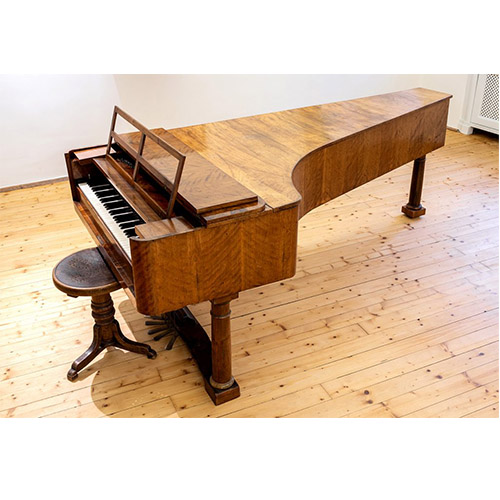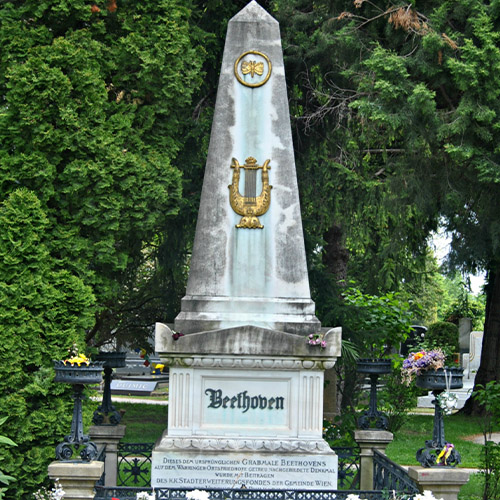Y3. Lesson 21. Composers - Ludwig van Beethoven
Prior learning: None
Duration: 30 minutes
Materials: Recorders
Keywords: Beat, rhythm, singing, chanting, partners, rhymes, circle games.
Difficulty: ![]()
Prepare
Present
Composers - Ludwig van Beethoven
Practise

Ludwig van Beethoven, baptised on December 17, 1770, in Bonn and passing away on March 26, 1827, in Vienna, is a monumental figure bridging the Classical and Romantic musical eras. Celebrated as possibly the most influential composer to have ever lived, Beethoven's work transcends the conventions established by his predecessors like Haydn and Mozart, weaving the burgeoning ideas of humanism, nationalism, and philosophical thought evident in the era's literature and philosophical discourse.
His compositions, often devoid of spoken text, articulate a profound philosophical narrative, embodying the quintessence of human will and emotion. Notably, his Sixth Symphony introduced the concept of program music, aiming to express emotion rather than depict scenes. Beethoven also innovated musical forms, expanding the sonata, symphony, concerto, and quartet, and uniquely merged vocal and instrumental music in his Ninth Symphony. His life was a testament to overcoming adversity, notably his battle with deafness, during which he produced some of his most significant works. Beethoven's ability to support himself through his compositions, independent of traditional patronage, marks a significant shift in the composer's societal role.
 Melodic development
Melodic development
![]() Students add an afro-american spiritual song to their repertoire.
Students add an afro-american spiritual song to their repertoire.
- Teach that "Chatter with the Angels" is a joyful song that African American people created long ago. It's about talking and being happy with angels in heaven. The music is cheerful and makes you want to clap and sing along. It's like imagining a bright, happy place filled with friendly angels.
- Teach the song line-by-line until secure.
- This song has a learning intention that will be discussed in forthcoming lessons.

 Rhythmic development
Rhythmic development
![]() Students discover how to read and say the time syllables of a song.
Students discover how to read and say the time syllables of a song.
- Project or print out the score.
- As musical detectives, students must use time names to describe the song's score.
- For example, the first measure reads: tika ttika, ti-ti.
- Choose a student to read the first measure.
- Ask the class to indicate the correctness of the answer by thumbs up or thumbs down.
- Repeat with another student for the next measure until the song's end.
- Remember to refresh students' awareness of the recently learned ti-tika time name.
 Creative movement
Creative movement
![]() Students sing and clap in this seated circle game.
Students sing and clap in this seated circle game.
- Students are seated in a large circle.
- A student is chosen to patrol the outside of the circle with a prop (such as a cap).
- Lead the class singing the song as students put the beat on their laps.
- The chosen student skips to the beat.
- On the words 'one for me', they touch the cap to the nearest student's head.
- On the words 'one for you', they touch the cap to the next student's head.
- On the words 'one for sister/brother [student name], the student places the cap on the head of the last student.
- That student now patrols the perimeter, and the game begins again.
 Listening
Listening
![]() Students discover some music by Ludwig van Beethoven.
Students discover some music by Ludwig van Beethoven.
Class discussion
- Discuss the differences between the two pieces of music.
- Ask students to use the musical terms that they have previously discovered.
- Ask if the Moonlight Sonata is played legato or staccato and if the dynamics are piano or forte.
- Ask volunteers what they feel and think when they hear this music.
- Ask the same questions for the beginning of Symphony No.5. Do the dynamics change in the music? Is the start staccato or legato?
- Play the first track. Teach that Ludwig van Beethoven's "Moonlight Sonata" is a beautiful piano piece. Imagine looking at the moonlit landscape by a window on a quiet night.
- It starts with slow, gentle notes that feel like moonbeams dancing on water. Beethoven created this music to express deep feelings without using any words.
- It is like he's telling a story of calmness, mystery, and beauty, all with the piano.
- Play the second track. Beethoven's Symphony No. 5 is like a thrilling adventure story told with music. It starts with four famous notes, "Da-da-da-DUM"—like knocking on a door or a call to action.
- This music is full of energy and big feelings. Beethoven uses the orchestra to take us on a journey through stormy weather to sunny skies. It feels like he's showing us how to find hope and joy after facing challenges. The music gets louder and more exciting until it ends with a victorious celebration.






